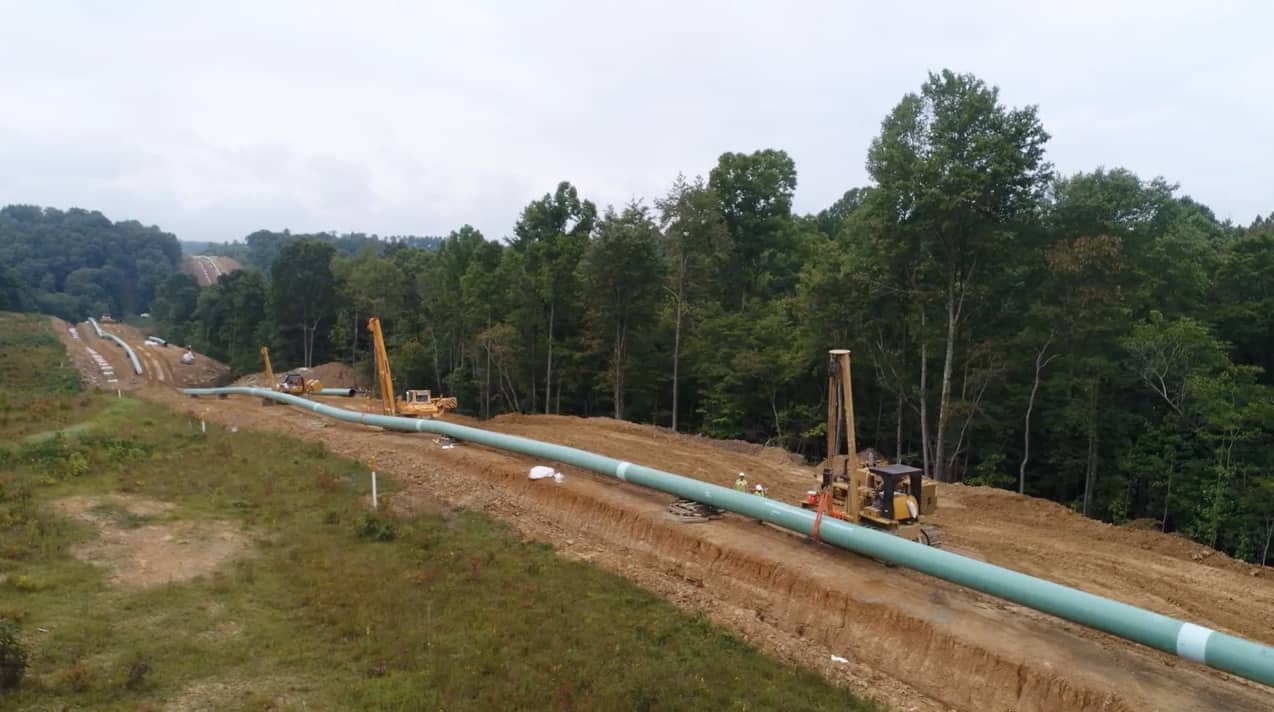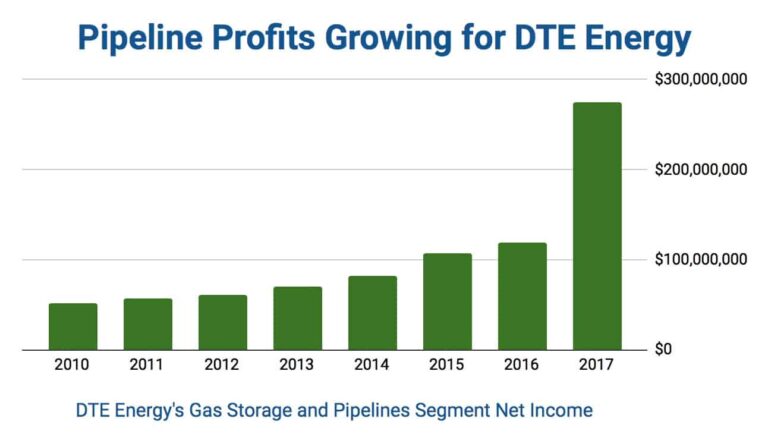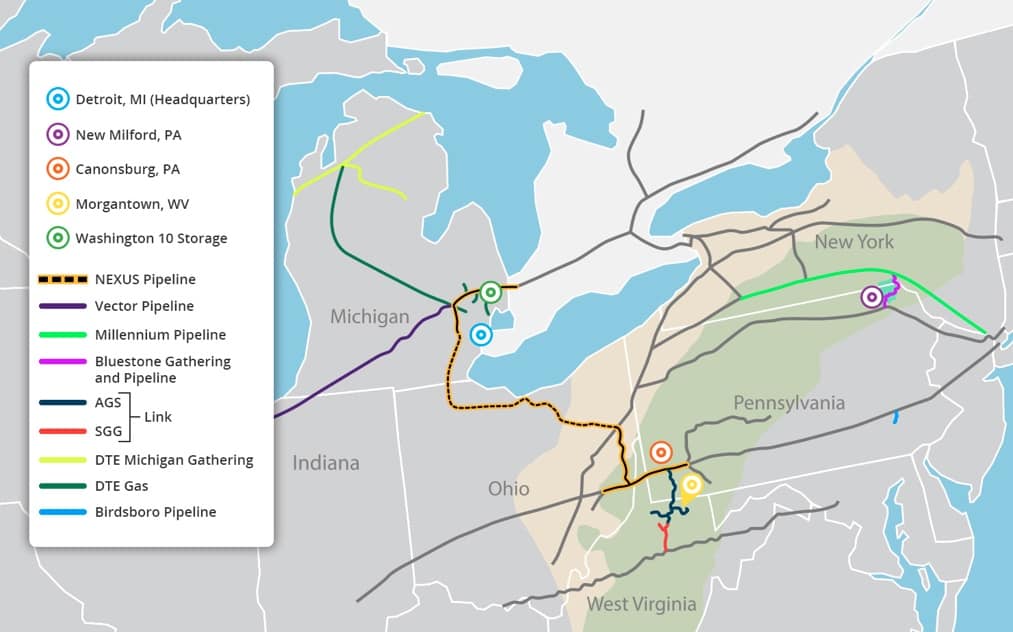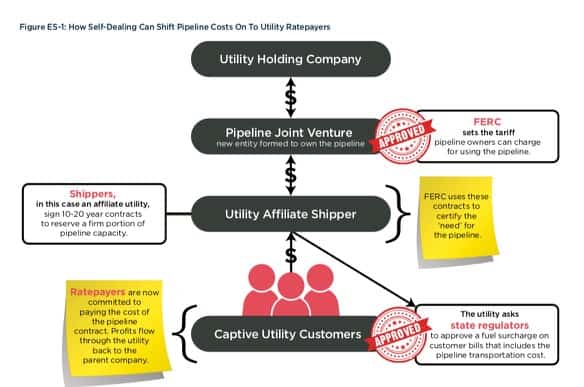Soaring Pipeline Profits May Be Driving DTE Energy’s Proposed New Gas Plant; Creates Conflict of Interest

DTE Energy’s CEO Gerry Anderson had a lot to be proud of when his company reported its 2017 financial results last month. Revenue increased from $10.6 billion in 2016 to $12.6 billion, while net income was $1.1 billion last year, up from $868 million in 2016.
“2017 was a very good year for DTE,” Anderson said.
Most of DTE’s 2.2 million customers think of the company as their electric or gas utility. But a large share of the company’s recent financial success and growth has come from an entirely different part of the company that customers never see: DTE’s Gas Storage and Pipelines business segment. It accounted for $275 million of DTE’s $1.1 billion in net income.
In fact, the gas pipeline infrastructure segment’s role in driving executives’ and shareholder earnings has ballooned over the years.
From 2010 to 2017, the gas pipeline and storage segment went from contributing $51 million of DTE’s net income to contributing $275 million, a 439% increase over that timespan.

Some of the natural gas pipelines owned by DTE Energy that have helped increase income include the Appalachia Pipeline, the Stonewall Pipeline, and Bluestone Pipeline, the latter of which was also celebrated on the investor call by DTE executives for achieving a 1 billion cubic feet (BCF) per day delivery capacity.
“This is pretty exciting, given that this pipeline started with 0.3 BCF per day capacity. We are expanding by an additional 0.1 BCF per day in 2018,” said Peter Oleksiak, DTE Energy’s senior vice president and CFO. For context, the controversial Atlantic Coast Pipeline that is partially owned by utilities Dominion and Duke Energy expects to ship 1.5 BCF per day.

DTE Energy also has a 50% ownership in the NEXUS Pipeline, a 255-mile pipeline that the company hopes will transport 1.5 BCF per day of fracked gas from the Utica and Marcellus shale to Ohio, Ontario, and Michigan markets. NEXUS is scheduled to be completed in the fall of 2018.
The company plans to invest between $2.8 and $3.4 billion over the next five years in its gas pipelines segment, which means profits will likely continue to rise as Anderson and the company work to build more fossil fuel infrastructure. However, DTE Energy needs utilities to build natural gas power plants as replacements for their retiring coal units to justify building more gas pipelines.
DTE Energy’s President and COO Jerry Norcia said as much on the annual earnings call last month (emphasis added):
Certainly, with our current slate of assets tied to the Marcellus and the Utica, we kind of see a world class resource connected to very proximal markets on the East Coast as well as Midwest … which is what our Nexus pipeline is pointed to. You are going to see a fundamental shift from coal use to natural gas use over time, as these plants age out, as you can see from our sort of plants for generation. So I see very strong supply growth as well as strong demand growth in the regions that we are going to serve with NEXUS.
In other words, DTE’s ability to keep growing its pipeline business, and the attendant profits, depends on whether or not it can find buyers to contract for the gas its shipping from the fracking fields.
DTE is already running into a problem in that regard, since the NEXUS pipeline is only about 60% subscribed. If another offtaker comes along to buy more of the gas, that would help protect DTE Energy’s Gas and Pipelines earnings.
Enter DTE Electric and its captive customers.
The regulated electric utility business arm of DTE Energy is currently waiting for the Michigan Public Service Commission to decide if it can construct a new billion dollar, 1,100-megawatt natural gas plant, to be funded by electric customers’ bills. Shareholders earn about a 10% profit on that investment.
Critics have suggested that the heavy growth of DTE’s natural gas pipelines and storage subsidiary creates a conflict of interest, and that the parent company will use its electric customers as a captive funding source to build gas-fired power plants like the one in St. Clair, whether the power plants are the right move for electric customers or not. That would create the artificial demand necessary to justify the continued construction of pipelines.
“It’s sort of the embodiment of a wholesale shift to natural gas … It’s not about just owning gas plants, it’s about having an interest in the extraction and transport as well. I think it’s a risky business model,” Sam Gomberg, a senior analyst with the Union of Concerned Scientists, said in an interview with Midwest Energy News’ Andy Balaskovitz.
In 2017, Oil Change International, in collaboration with Public Citizen and Sierra Club, published a report titled “Art of the Self-Deal” that called into question the need for the NEXUS Pipeline. The report highlighted the high returns that utility holding companies like DTE Energy get from pipeline development, another factor that explains why DTE’s pipeline investments would also drive it to build natural gas plants:
FERC allows a return on equity of 14 percent for new interstate gas pipelines … This comparatively high return provides an incentive for utility holding companies and gas producers to enter into the pipeline business, especially as utilities face stagnant or declining revenues from electricity sales. It also incentivizes the building of new infrastructure over the efficient use of existing pipelines, which have been paid off by previous ratepayers.

DTE has said that it has not yet made a decision what company will provide the fuel to the St. Clair natural gas plant.
Clean energy advocates have criticized DTE’s modeling that shows the natural gas plant is needed and is the cheapest option as deeply flawed.
Those advocates used the same software that DTE used in its own models and argued that DTE Electric can save consumers $339 million over a 25-year period by using renewable energy instead of building the gas plant. Thomas Beach, a consultant and former California utility commission staffer, ran the advocates’ modeling. E&E News’ also highlighted how the modeling could defer the need for the plant by at least five years, which could allow the cost of renewable energy and battery storage to further decline.
The MPSC’s professional staff agreed, concluding that DTE “should have used higher prices in its natural gas high price case … this could mean that the company’s proposed project is not the most reasonable and prudent choice.” The staff did say that DTE Electric met the minimum requirements in the statute to earn approval, although the utility asked for permission to build the gas plant just months before new guidance for staff went into effect that could have resulted in staff issuing a different opinion.
Photo sources: https://dtemidstream.com/company/; Oil Change International; YouTube


